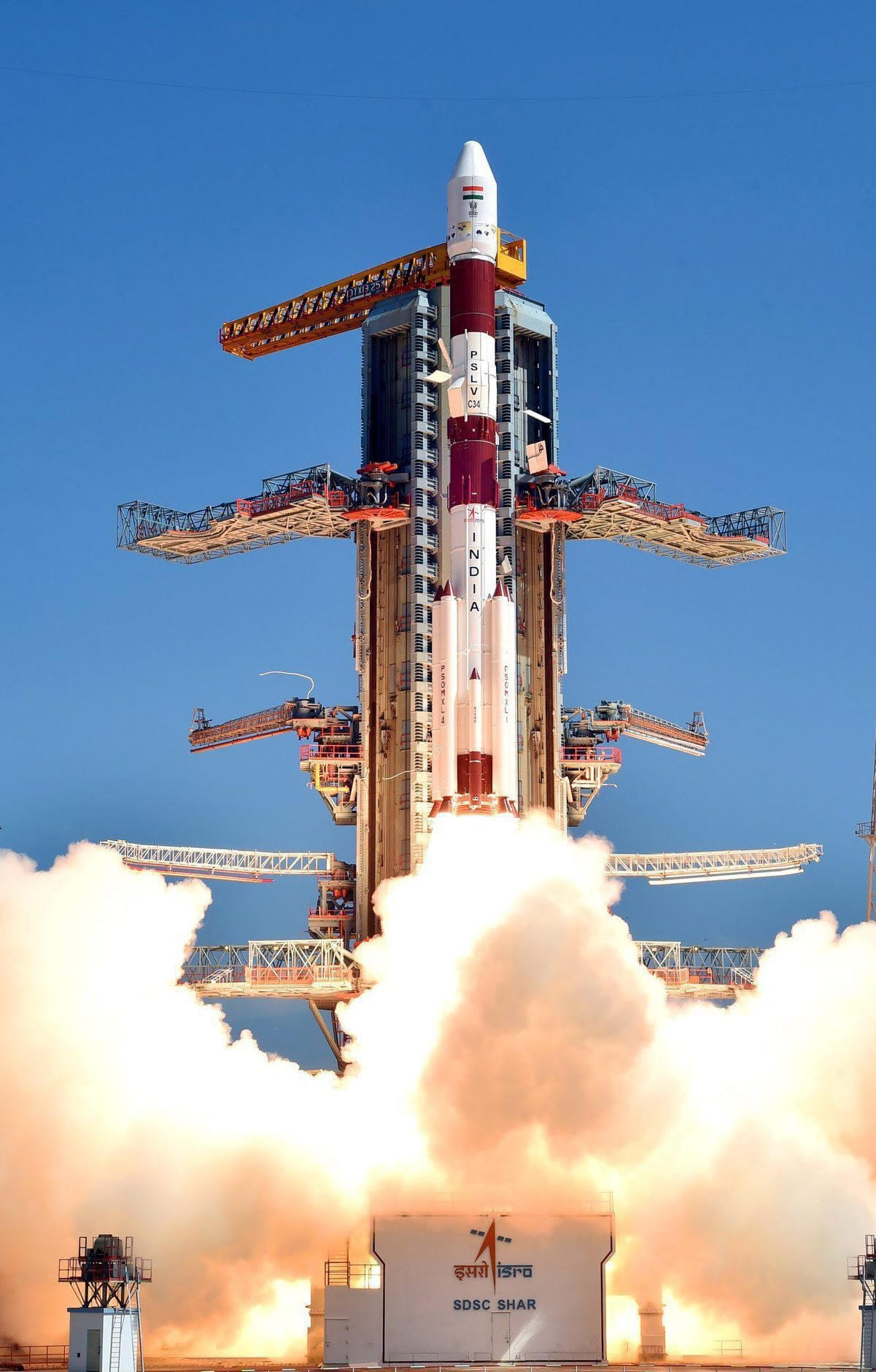Highlights
India’s space program is shifting from one that was purely oriented towards developmental needs to one that seeks to address its security needs.
Increasing competition between Asian powers is also being reflected in the space programmes of these powers.
The increasing need for rethinking global governance in space provides India with an opportunity for leadership given its expanding space capabilities.
SPARC Brief
India

PSLV rocket lift-off. Photo credit: Observer Research Foundation, file photo.
July 2020
Overview
India’s space program started in the early 1960s, with the creation of the Indian National Committee for Space Research (INCOSPAR) in 1962. The INCOSPAR would become the Indian Space Research Organization (ISRO) in 1969, the agency which currently continues to lead India’s space effort. The initial efforts were based upon the American Nike-Apache sounding rockets launched from the Thumba Equatorial Rocket Launching Station (TERLS).
Since then India has made steady progress. By the late 1970s, India was ready to launch its own space rockets, the first of which was the ISRO designed rocket, SLV-3 (Satellite Launch Vehicle-3), which had its first successful launch in 1980. The ISRO has made significant progress, moving from the SLV-3 to the PSLV (Polar Satellite Launch Vehicle), versions of which continue to be used by the ISRO.[1] However, the interest in launching a heavier payload into geo-stationary orbits led to the GSLV (Geosynchronous Satellite Launch Vehicle), which was first launched in 2001, and which remains active.
In addition to rockets, the ISRO focused on developing satellites as a critical mission, given India’s vast needs for earth observation, weather forecasting and telecommunications. Since the 1970s, the ISRO has designed, built and launched a vast array of satellites, including some for military purposes. More recently, the ISRO has also been pursuing planetary missions, sending orbiter probes to both the Moon and Mars.
Industrial Base
Faced with India’s significant domestic developmental challenges, India’s space program was developed with the primary objective of addressing the social and economic needs of the country. Given this focus, ISRO initiated its communication satellites, the Indian national satellite (INSAT) series, starting with the launch of INSAT-B in 1983. This revolutionized India’s communication sector, with applications in television broadcasting, satellite news, weather forecasting, disaster warning, and search and rescue missions. The INSAT system supports operations across multiple frequency bands including C, Ku, S and UHF. A second focus area for the ISRO has been its remote sensing or earth observation satellites, with state-of-the-art cameras providing images of the Earth in different resolutions, bands and swaths.
Faced with India’s significant domestic developmental challenges, India’s space program was developed with the primary objective of addressing the social and economic needs of the country.
Initially the ISRO was dependent on the Soviet Union for launching its satellites. To reduce this dependence, it next focused on its own satellite launch vehicle program. This resulted in the first successful test of satellite launch vehicle (SLV) in 1980. ISRO developed a subsequent vehicle based on the SLV design called the Augmented Satellite Launch Vehicle (ASLV). However, it had several failed launches and finally one successful attempt in 1994. Given financial constraints and because these vehicles could only launch payloads up to 150 kilograms into low-earth orbit, ISRO decided to end both these programs. It then started work on its current workhorses – the Polar Satellite Launch Vehicle (PSLV) and the Geosynchronous Launch Vehicle (GSLV).
Nevertheless, India continued to have capacity issues when it came to launching heavier satellites. This led to international collaboration with partners such as France, which had the capability to launch India’s heavier satellites. India then began the development of versions of the GSLV, the GSLV-MK I, II and III, in order to address this capacity gap. The GSLV MK I used a Russian cryogenic engine, KVD-1M, and was commissioned into service in May 2003. GSLV MK II used an Indian-built cryogenic upper stage to power stage 3 of the mission. The GSLV MK III had its first test launch in June 2017. A version of the GSLV MK III (M1) was used for India’s Chandrayaan-2 (lunar) mission to send the launcher up to Earth Parking Orbit in July 2019, and is also being planned for India’s manned space mission.
Law & Policy
India has yet to announce a formal, open space policy. In the civilian sector, it has sectoral policies that guide the government in areas like satellite communication and remote sensing, but even these are quite broad. On the security side, traditionally, India had a doctrinaire approach towards space security, highlighting the peaceful use of outer space and opposing the weaponization and militarization of outer space. However, that perspective has changed recently. Initially, since India had rudimentary space capabilities, it was one of the vocal critics of the US Strategic Defense Initiative (SDI) popularly known as the “Star Wars” program and the anti-satellite (ASAT) tests by the US and the USSR.
A couple of factors led to a change in Indian policy in the early 2000s. The first was a changing security environment, with Pakistan’s acquisition of long-range missiles. The second was China’s supply of short- and medium-range missiles to Pakistan. These factors induced India to adopt a new approach to ballistic missile defense, leading it to adopt a fairly positive stance toward the George W. Bush administration’s decision to leave the Anti-Ballistic Missile (ABM) treaty in late 2001. As India’s own capabilities have developed, it has taken a more nuanced approach to space security and missile defence issues, emphasizing national security alongside developmental objectives.
As India’s own capabilities have developed, it has taken a more nuanced approach to space security and missile defence issues, emphasizing national security alongside developmental objectives.
Furthermore, China’s ASAT test in January 2007 became a watershed moment for India leading to a review of India’s approach to outer space.[2] India began to acknowledge the cost and vulnerabilities from China’s ASAT program and this led to a new debate about how best to protect its own assets. Since then, India has undertaken both institutional innovation as well as space security prioritization in its overall approach to outer space. Mindful of its experience in the nuclear domain – and in an effort to avoid a repeat of the situation arising out of the Treaty on the Non-Proliferation of Nuclear Weapons in which a treaty mechanism could prevent India from conducting an ASAT test – New Delhi demonstrated its own ASAT capability in March 2019. Thereafter, in April 2019, India established the Defence Space Agency (DSA) as an interim institutional arrangement to organize its military space capabilities. All of these changes reflect a more mature and nuanced Indian approach to outer space as compared to the earlier approach that opposed any militarization of outer space.
International Engagements
India had traditionally cooperated on outer space affairs with France, the United States and the Soviet Union. Even though Asia houses several established and emerging space players, space cooperation amongst Asian powers has been fairly minimal. This is driven by the fact that Asia is also a more competitive and contested space in geopolitical terms and thus, the scope for collaboration has remained small.[3] The competition in Asia is reflected in the fact that there exist two regional space cooperation initiatives in the Asia-Pacific – APSCO under Chinese leadership and APSRAF under Japanese leadership. A cursory look at the membership of these organisations reflects the divisions in Asia – for instance, India and South Korea are members of the APRSAF and Pakistan is part of APSCO.
Even though Asia houses several established and emerging space players, space cooperation amongst Asian powers has been fairly minimal.
While this has remained the story so far, there are some new partnerships and alliances being established in Asia. For instance, India and Japan have decided to cooperate and deepen the partnership between the Japan Aerospace Exploration Agency (JAXA) and the ISRO in a number of important areas, including earth observation, satellite-based navigation, space sciences and lunar exploration. The two countries have had their own independent lunar missions, but India and Japan have yet to make a significant dent especially in comparison to China’s accomplishments. For example, China landed on the near side of the Moon in 2013 and on the far side of the Moon in 2019. These are mere reflections of how the geopolitics on earth are being reflected in the outer space as well.
India is also beginning to find other partners in Asia – engagements with South Korea and Vietnam are cases in point. Prime Minister Modi’s outreach to the South Asian neighbourhood with the launch of the South Asia satellite in 2017 is another instance of how India is finally making a diplomatic pitch using outer space.[4] In order to further operationalise the South Asia satellite, ISRO built a ground tracking and data reception station in Thimphu so that Bhutan’s requirements could be partially met by the Indian satellite.
Trajectories
Indian space technologies will continue to be developed and improved in the years ahead, with implications for both commercial and military applications. However, India has yet to take the lead in the realm of global space governance. This is an area where an impasse exists and there has been a crisis in decision-making where developing a consensus among major powers has been an important challenge.[5] The Conference on Disarmament, the UN body where space security matters are discussed, has been stalemated for more than two decades, with member states not even able to agree on the annual programme of work. The most recent UN Group of Governmental Experts (GGE) in 2018-19 ended without a consensus report, demonstrating yet again the serious challenges with regard to space governance. In this regard, India may consider partnering with like-minded countries in developing technology-aided and verification-based solutions that can facilitate some movement on global space governance.
Endnotes
[1] PV Manoranjan Rao, BN Suresh and VP Balagangadharan, From Fishing Hamlet to Red Planet: India’s Space Journey (New Delhi, India: Harper Collins Publishers India, 2015); Rajeswari Pillai Rajagopalan, “India’s Space Ambitions and Capabilities,” in Sumit Ganguly , The Oxford Handbook of India’s National Security (New Delhi: Oxford University Press, 2018).
[2] Rajeswari Pillai Rajagopalan, “India’s Changing Policy on Space Militarization: The Impact of China’s ASAT Test,” India Review, 2011, 10 (4), pp. 354-378.
[3] Ajey Lele, Asian Space Race: Rhetoric or Reality? ($$$ : Springer, 2013); James Clay Moltz, Asia’s Space Race: National Motivations, Regional Rivalries, and International Risks (New York: Columbia University Press, 2012), 79–83).
[4] Vidya Sagar Reddy, “Improving South Asian space cooperation,” The Space Review, 28 March 2016, https://www.thespacereview.com/article/2951/1
[5] Rajeswari Pillai Rajagopalan, “It Is Time for Space Governance Talks,” The Diplomat, 21 May 2020, https://thediplomat.com/2020/05/it-is-time-for-space-governance-talks/; Rajeswari Pillai Rajagopalan, “Achieving global cooperation in space security: Settling for less than the ideal,” in Space Security Index 2018 (Ontario, Canada: Project Ploughshares, 2018).
Dr. Rajeswari Pillai Rajagopalan is a Distinguished Fellow and Head, Nuclear & Space Policy Initiative, Observer Research Foundation, New Delhi.
Dr. Sumit Ganguly is a Distinguished Professor of Political Science and holds that Tagore Chair in Indian Cultures and Civilizations at Indiana University Bloomington.
The views expressed in this SPARC Brief are those of the authors, and do not reflect the official policy or position of SPARC or the University of Washington.
